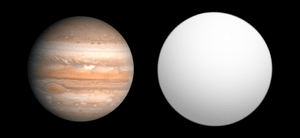WASP-10b
| Exoplanet | List of exoplanets | |
|---|---|---|
 | ||
| Parent star | ||
| Star | WASP-10 | |
| Constellation | Pegasus | |
| Right ascension | (α) | 23h 15m 58s |
| Declination | (δ) | +31° 27′ 46″ |
| Apparent magnitude | (mV) | 12.70 |
| Distance | 290±70 ly (90±20 pc) | |
| Spectral type | K5 | |
| Orbital elements | ||
| Semi-major axis | (a) | 0.0371+0.0014 −0.0013 AU |
| Eccentricity | (e) | 0.057+0.011 −0.005 |
| Orbital period | (P) | 3.0927616+1.12E-5 −1.82E-5 d |
| Inclination | (i) | 86.8+0.6 −0.5° |
| Argument of periastron |
(ω) | 2.737+0.194 −0.166° |
| Time of transit | (Tt) | 2454357.85803+0.00042 −0.0003 JD |
| Physical characteristics | ||
| Mass | (m) | 3.06+0.23 −0.21 MJ |
| Radius | (r) | 1.08 ± 0.02 RJ |
| Density | (ρ) | 3220 kg m−3 |
| Surface gravity | (g) | 6.93 g |
| Temperature | (T) | 1300 |
| Discovery information | ||
| Discovery date | April 1, 2008 | |
| Discoverer(s) | Cameron et al. (SuperWASP) | |
| Discovery method | Transit | |
| Discovery site | SAAO | |
| Discovery status | Published | |
| Database references | ||
| Extrasolar Planets Encyclopaedia | data | |
| SIMBAD | data | |
| Exoplanet Archive | data | |
| Open Exoplanet Catalogue | data | |
WASP-10b is an extrasolar planet discovered in 2008 by SuperWASP using the transit method. Follow-up radial velocity observations showed that it is three times more massive than Jupiter, while the transit observations showed that its radius is 8% bigger than Jupiter, quite small for a Hot Jupiter but this is due to its high mass. This makes the density of this planet similar to our Moon. Its takes 3 days to orbit around the star, in contrast to 365 days for the Earth to go around the Sun.[1]
<ref "name=disc">Christian; Gibson, N. P.; Simpson, E. K.; Street, R. A.; Skillen, I.; Pollacco, D.; Collier Cameron, A.; Joshi, Y. C.; et al. (December 29, 2008). "WASP-10b: a 3MJ, gas-giant planet transiting a late-type K star". Monthly Notices of the Royal Astronomical Society. 392 (4): 1585–1590. arXiv:0806.1482![]() . Bibcode:2009MNRAS.392.1585C. doi:10.1111/j.1365-2966.2008.14164.x.</ref>
It is the only confirmed extrasolar planet in WASP-10's planetary system, since the only other detected planet in WASP-10's planetary system, WASP-10c, is still unconfirmed.[2]
. Bibcode:2009MNRAS.392.1585C. doi:10.1111/j.1365-2966.2008.14164.x.</ref>
It is the only confirmed extrasolar planet in WASP-10's planetary system, since the only other detected planet in WASP-10's planetary system, WASP-10c, is still unconfirmed.[2]
See also
References
- ↑ Johnson; Winn, Joshua N.; Cabrera, Nicole E.; Carter, Joshua A. (2009). "A SMALLER RADIUS FOR THE TRANSITING EXOPLANET WASP-10b". The Astrophysical Journal Letters. 692 (2): L100–L104. arXiv:0812.0029
 . Bibcode:2009ApJ...692L.100J. doi:10.1088/0004-637X/692/2/L100.
. Bibcode:2009ApJ...692L.100J. doi:10.1088/0004-637X/692/2/L100. - ↑ "Extrasolar Planets Encyclopaedia - WASP-10".
External links
![]() Media related to WASP-10b at Wikimedia Commons
Media related to WASP-10b at Wikimedia Commons
- WASP Planets
- WASP-10b: a 3MJ, gas-giant planet transiting a late-type K star
- WASP-10b at the SIMBAD Astronomical Database.
- Ids - Bibliography - Image - B&W Image.
Coordinates: ![]() 23h 15m 58s, +31° 27′ 46″
23h 15m 58s, +31° 27′ 46″